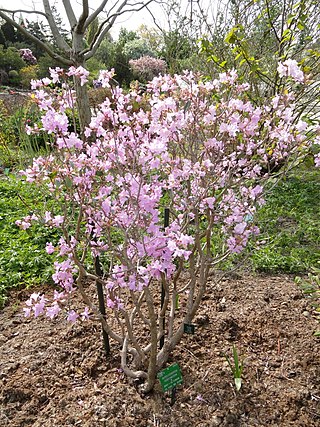
Acanthaceae is a family of dicotyledonous flowering plants containing almost 250 genera and about 2500 species. Most are tropical herbs, shrubs, or twining vines; some are epiphytes. Only a few species are distributed in temperate regions. The four main centres of distribution are Indonesia and Malaysia, Africa, Brazil, and Central America. Representatives of the family can be found in nearly every habitat, including dense or open forests, scrublands, wet fields and valleys, sea coast and marine areas, swamps, and mangrove forests.

Leucas is a genus of plants in the family Lamiaceae, first described by Robert Brown in 1810. It contains over 200 species, widespread over much of Africa, and southern and eastern Asia with a few species in Queensland and on various islands in the Indian Ocean.

Pandanus is a genus of monocots with some 578 accepted species. They are palm-like, dioecious trees and shrubs native to the Old World tropics and subtropics. The greatest number of species are found in Madagascar and Malaysia. Common names include pandan, screw palm and screw pine. They are classified in the order Pandanales, family Pandanaceae.

Boswellia is a genus of trees in the order Sapindales, known for its fragrant resin. The biblical incense frankincense is an extract from the resin of the tree Boswellia sacra, and is now produced also from B. frereana. Boswellia species are moderate-sized flowering plants, including both trees and shrubs.

Barleria is a genus of plants in the family Acanthaceae. It includes 303 species native to the tropics and subtropics, including the Americas from Mexico to northern South America, sub-Saharan Africa, Egypt and the Arabian Peninsula, the Indian subcontinent, Indochina, southern China and Taiwan, parts of Malesia, and New Guinea.

Romneya trichocalyx, the bristly Matilija poppy or hairy Matilija poppy, is a species of flowering plant in the poppy family. This poppy is native to San Diego, Ventura, and Santa Barbara counties in California, as well as Baja California, Mexico, where it grows in dry canyons in chaparral and coastal sage scrub plant communities. Like its relative Romneya coulteri, it is used as an ornamental plant, kept for its large, showy flowers.

Kleinia scottii is a species of flowering plant in the family Asteraceae. It is found only in Yemen. Its natural habitat is subtropical or tropical dry forests.

Pulicaria is a genus of flowering plant in the sunflower family, native to Europe, Asia, and Africa. In North America Pulicaria is known by the common name false fleabane.
Ballochia is a genus of flowering plant in the family Acanthaceae. It is endemic to Socotra. It contains the following species:

Exacum is a genus of plant in family Gentianaceae. It contains the following species :
Trichocalyx obovatus is a species of plant in the family Acanthaceae. It is endemic to Yemen. Its natural habitats are subtropical or tropical dry forests and subtropical or tropical dry shrubland.
Trichocalyx orbiculatus is a species of plant in the family Acanthaceae. It is endemic to Yemen. Its natural habitats are subtropical or tropical dry forests and subtropical or tropical dry shrubland.

Trichodesma is a genus of flowering plants in the borage family, Boraginaceae. There are about 40 to 45 species distributed in tropical and subtropical regions of Africa, Asia, and Australia.

Rhododendron rigidum (基毛杜鹃) is a rhododendron species native to Sichuan and Yunnan, China, where it grows at altitudes of 2,000–3,400 m (6,600–11,200 ft). Growing to 1–2 m (3.3–6.6 ft) in height, it is an evergreen shrub with leaves that are elliptic, oblong elliptic, oblong-lanceolate or oblanceolate, 2.5–6.8 by 1–3.2 cm in size. The flowers are white to reddish purple.

Rhododendron rubiginosum (红棕杜鹃) is a rhododendron species native to Myanmar, and Sichuan, Xizang, and Yunnan in China, where it grows at altitudes of 2,800–3,600 m (9,200–11,800 ft). This evergreen shrub grows to 1–3 m (3.3–9.8 ft) in height, with leaves that are elliptic or elliptic-lanceolate or oblong-ovate, 3.5–8 by 1.3–3.5 cm in size. The flowers are pink, red, or pale purple.

Rhododendron wardii (黄杯杜鹃) is a rhododendron species native to southwestern Sichuan, southeastern Xizang, and northwestern Yunnan in China, where it grows at altitudes of 3,000–4,600 m (9,800–15,100 ft). This evergreen shrub grows to 3 m (9.8 ft) in height, with leathery leaves that are narrowly ovate to oblong-elliptic or broadly ovate-elliptic, 5–8 by 3–4.5 cm in size. The flowers are yellow or white.

Rhododendron vernicosum (亮叶杜鹃) is a rhododendron species native to western Sichuan, southeastern Xizang, and western Yunnan, China, where it grows at altitudes of 2,600–4,300 m (8,500–14,100 ft). It is an evergreen shrub typically growing to 1–5 m (3.3–16.4 ft) in height, with leathery leaves that are oblong-ovate to oblong-elliptic, and 5–12.5 × 2.3–4.8 cm in size. The flowers are somewhat fragrant, and pale pink or white.
The 2018 National Women's Soccer League season was the sixth season of the National Women's Soccer League, the top division of women's soccer in the United States. Including the NWSL's two professional predecessors, Women's Professional Soccer (2009–2011) and the Women's United Soccer Association (2001–2003), it was the twelfth overall season of FIFA and USSF-sanctioned top division women's soccer in the United States. The league is operated by the United States Soccer Federation and receives major financial backing from that body. Further financial backing is provided by the Canadian Soccer Association. Both national federations pay the league salaries of many of their respective national team members in an effort to nurture talent in those nations and take the financial burden off individual clubs.













